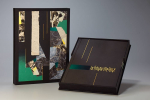La fragua/The Forge is a unique artists’ book, which includes five poems by Federico García Lorca, and nine original drawings by Manuel Neri. The poem Hay almas que tienen… was written on February 20, 1920, and appeared in Lorca’s first book of poetry, Libro de Poemas, published in 1921 in the printshop of Gabriel García Maroto, Madrid. The English translation by Catherine Brown is entitled Some Souls…. The poem Murió al amanecer is from the book Canciones (1921-24), which was first published in 1927 by Litoral, Malaga, and in a second edition by Revista de Occidente, Madrid in 1929. The English translation by Alan S. Trueblood is entitled Dead at Daybreak. The poem Gacela de la terrible presencia is from the book Diván del Tamarit, written in 1931-34 and published posthumously in 1940 in a special edition of Revista Hispánica Moderna by Columbia University, New York. The English translation by Catherine Brown is entitled Ghazal of the Terrible Presence. The poems ¡Ay! and Puñal were included in Lorca’s book Poema del cante jondo, published in May 1931 by Ulises, Madrid. The English translation of ¡Ay! is by Robert Nasatir. The English translation of Puñal, titled Dagger, is by Cola Franzen.
The drawings by Manuel Neri, in ink, graphite, charcoal, and oil pastel, are from the series Standing Figure Study and Niñas de las Américas done in 1981, and were selected by Manuel Neri to accompany the poems for this book. The Introduction was written in English by Mary Julia Klimenko and translated into Spanish by Jaime Moreno Villarreal. The calligraphy of the text and page designs were created and executed by Thomas Ingmire on Rives BFK White paper in the Spring of 2008. The calligraphy for the Introduction, biographies, and colophon was done by Akiho Sugiyama.
The binding structure and leather binding for the book were designed by Daniel E. Kelm and produced by Daniel E. Kelm, Kylin Lee and other mechanics at the Wide Awake Garage in Easthampton, Massachusetts. The book is bound in goatskin leather, with a cover design that combines hand-tooling and die-stamping in gold leaf. The book is housed in a handmade paper-covered box produced by Foolscap Press in Santa Cruz, California. The uniquely painted designs, calligraphy, and collage elements on the cover of the box are by Thomas Ingmire.



